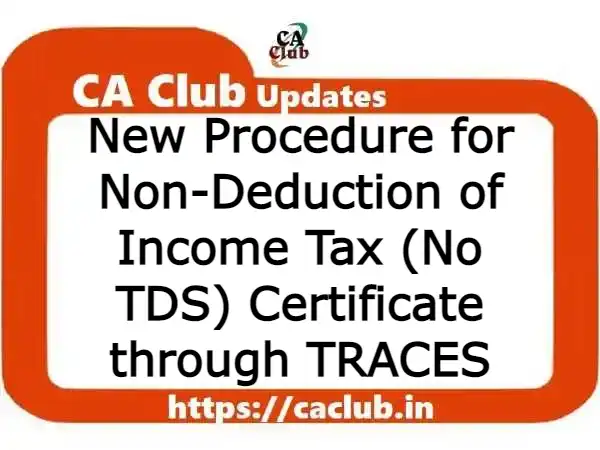The CBDT has introduced a new procedure, format, and standards for filing applications in Form 15C and 15D. These forms allow for the grant of a certificate for non-deduction of income tax (No TDS Certificate) under sub-section (3) of section 195 of the Income Tax Act, 1961. This new process, facilitated through the TRACES platform, will streamline the application process and make it more accessible for taxpayers.
CBDT has issued Systems Notification 1/2023 relating to grant of certificates for the deduction of tax at nil rate for persons entitled to receive interest or other sums without deduction of tax at source under Section 195(3) of the Income-tax Act read with IT Rule 29B. The DGIT (Systems) has prescribed the procedure, format, and standards for filing these forms electronically at the TRACES website along with supporting documents, including the data from previous financial years.
CBDT Income Tax Notification 1/2023 Systems dated 29/03/2023: New Procedure for Non-Deduction of Income Tax (No TDS) Certificate through TRACES
Overview of Section 195(3) & Rule 29B: Electronic Filing of Form 15C and 15D
Section 195(3) of the Income-tax Act, 1961, enables the grant of a no-tds certificate to individuals who are entitled to receive interest or other sums where income tax must be deducted under section 195(1). Rule 29B of the Income-tax Rules, 1962, outlines the rules for making an application for such a certificate.
1. Section 195(3) of the Income Tax Act, 1961
Section 195(3) of the Income Tax Act, 1961, deals with the provision of granting certificates to individuals or entities entitled to receive interest or other sums on which income tax is to be deducted under Section 195(1) without any deduction of tax at source. This provision allows taxpayers to receive their due payments without any tax deduction, provided they meet certain conditions and obtain the necessary certificate.
The main objective of Section 195(3) is to reduce the tax burden on taxpayers who are eligible for exemptions or lower tax rates. It is particularly beneficial for non-residents who may be subjected to double taxation on certain types of income.
2. Rule 29B of the Income Tax Rules, 1962
Rule 29B of the Income Tax Rules, 1962, prescribes the rules and procedures for making an application for a certificate authorizing the receipt of interest and other sums without deduction of tax in cases covered under Section 195(3). The application process for obtaining this certificate involves two forms: Form 15C and Form 15D.
3. Form 15C
This form is to be used by banking companies or insurers for making an application for a no-deduction certificate under Section 195(3).
4. Form 15D
This form is applicable for any other person (other than banking companies or insurers) who carries on business or profession in India through a branch.
The application for a no-deduction certificate under Rule 29B must be submitted to the Assessing Officer (AO) in the prescribed form. Upon receiving the application, the AO will review the information provided and determine whether the applicant is eligible for the certificate. If approved, the certificate will authorize the taxpayer to receive payments without tax deductions as per Section 195(3) of the Income Tax Act.
In summary, Section 195(3) of the Income Tax Act, 1961, and Rule 29B of the Income Tax Rules, 1962, work in conjunction to provide taxpayers with an option to obtain a no-deduction certificate for specific income types, ensuring they are not subject to tax deductions at source. By understanding and complying with the requirements and procedures laid out in these provisions, eligible taxpayers can enjoy the benefits of reduced tax liability on certain income types.
Procedure for Filing Applications on TRACES
To file an application in Form 15C or 15D, applicants must log in to the TRACES website and submit the form electronically. The applicant must first register with their Permanent Account Number (PAN) if they have not already done so. The form can be submitted using various authentication methods, such as digital signature, electronic verification code, AADHAR-based authentication, or mobile OTP.
Applicants accessing TRACES from outside India can only submit their application using a digital signature. After submission, the applicant can track the status of their application through the TRACES platform.
Assignment of Applications and Processing
Applications will be assigned to the appropriate TDS Assessing Officer (AO) based on the information provided by the applicant. Once the application has been successfully submitted, the AO will receive relevant data, including previous income tax returns, audit reports, and assessment orders.
The AO will process the application and seek clarification from the applicant if necessary. After approval or rejection, the application will be forwarded to the supervisory authority for further processing.
Role of Range Heads and Commissioners of Income-tax
Range Heads and Commissioners of Income-tax play a crucial role in the application process. They must review the application and grant administrative approval based on the information provided by the applicant and the recommendation of the AO.
Issuance of Certificate
Once the application has been approved, the AO will generate a certificate on the TRACES platform, which can then be downloaded by the applicant. The certificate will be system-generated and does not require a signature.
Sharing the Certificate with Deductor(s)
It is the responsibility of the applicant to share the certificate with the respective deductor(s) when the application has been made in Form 15C or 15D.
By implementing this new process, the CBDT aims to simplify the application procedure for taxpayers and improve efficiency in the Income-tax department.
